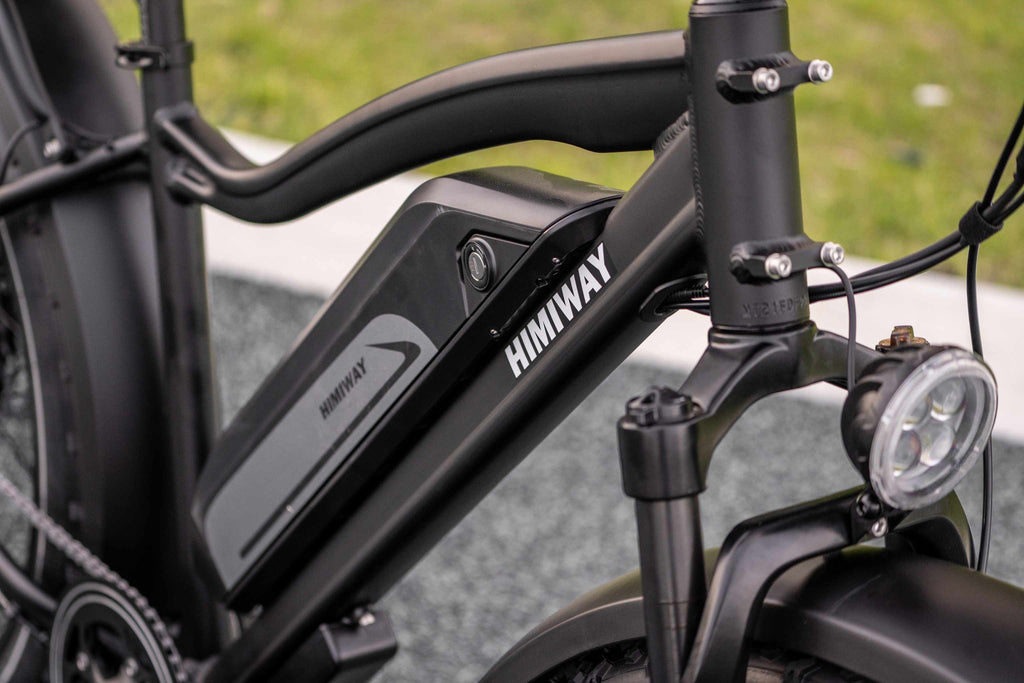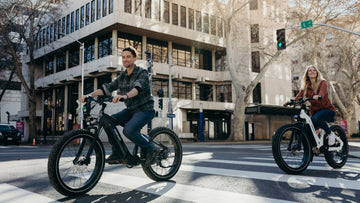Electric bikes are the new range for running errands, commuting, and exercising. Not only are they cost-effective and eco-friendly, but they also elevate your average ebike riding experience with their pedal-assist features.

According to CREDS researchers at the University of Leeds, England’s carbon dioxide emission can be reduced by 50% if e-bikes replace car travel.
An electric bike battery supplies power to the bike’s lightweight motor and is one of the vehicle’s core elements. The motor, in turn, assists the rider with pedaling, reducing the amount of human effort needed to ride the electric bike.
Like the Himiway Cruiser, most e-bikes are equipped with a rechargeable lithium-ion battery that is either built into the electric bicycle’s frame or mounted externally for easy charging and replacement.
Although an electric bike battery loses capacity over time, it can last a good 3 to 5 years if properly maintained. This article gives you all of the charging strategies you need to extend your electric bike battery’s life so you don’t have to worry about getting a replacement for a few years.
Following these tips, you’ll save money in the long run and maximize your bike’s performance.
Importance of Extending E-Bike Battery Life
An electric bike battery can cost anywhere from $500 to $900, depending on its capacity and brand. So, you want to avoid the high expense as long as possible by extending your e-bike’s battery life.
A healthy battery also means your fat tire motorbike will perform better and maintain high capacity for a longer time. That means longer and more consistent rides.
Not taking the necessary measures to prolong your electric bike’s battery life means you’ll need to buy new batteries more often. Extending your electric bike battery’s life, on the other hand, is eco-friendly because it’ll prevent more batteries from ending up in landfills.
Charging 101: Understanding Your E-Bike Battery
Before we get to the tips for a longer e-bike battery life, it’s important to know about the relevant terms and understand the affecting factors.
Electric Bike Battery Terms and Definitions:
- 1. Cycle Life: The amount of charge and discharge cycles a battery can go through before its capacity starts to fade.
- 2. Amp-hours (Ah): It’s the measurement of the total charge delivered to an electrical circuit in one hour.
- 3. Watt-hours (Wh): It’s the total power consumed or work done over one hour in an electric system.
- 4. Battery Capacity: The amount of energy that a battery can store.
- 5. Capacity Fade: A battery’s gradual decrease in capacity over time.
Factors That Affect Battery Life
- 1. Age: As your electric bike ages, its battery will lose capacity and efficiency.
- 2. Charge Cycles: When your battery charges and then discharges, it is considered one charge cycle. Different bikes can handle a different number of charge cycles before the battery starts to degrade.
- 3. Maintenance: Skipping moped bike maintenance and regular checks of your electric bicycle could result in major damage in the long run, which could be expensive to repair.
- 4. Temperature: Your electric bike battery degrades quicker when exposed to high temperatures.
- 5. Charging Patterns: Frequent charging, overcharging, and undercharging can harm your battery life.

Best Practices for Charging Your E-Bike Battery
1. When to Charge Your Battery
Regularly charge your electric bike battery after every ride and never let it completely run out. Try changing your hunting mountain ebike when its capacity is in the mid-range of 30%-60% for extended battery life.
2. Use the Charger Provided by the Manufacturer
The New York State Office of the Attorney General advised consumers only to use the manufacturer’s charger chord and adapter for their e-bike to prevent safety hazards. Each manufacturer designs a specialized charger according to the specification of its e-bike. So any other charger would be incompatible, and the BMS feature will not work correctly either.
3. Don’t Overcharge Your Battery
When you overcharge an electric bike battery, it continuously discharges the capacity to a lower percentage so that it doesn’t have to stop charging. These charge cycles can drastically affect your battery’s life. Some all-terrain electric bikes, such as the Himiway Zebra, have a battery management system (BMS) feature to protect their battery from overcharging, over-discharging, and overheating.
Tips for Maximizing Battery Life
- 1. Charge a new e-bike fully before using it. The long initial charge ensures that current flows through each cell. This conditions the new battery for optimal performance.
-
2. Buy a bike specially designed for the purpose you’ll use it for. For example, if you plan on making long commutes, get a long-range electric bike with a battery designed to withstand the long ride.
- 3. Keep your electric bike battery clean so that dust and grime don’t accumulate. The particles can hinder charge cycles and decrease the battery’s life.
- 4. Never let your electric bike battery completely discharge. To avoid running out of battery capacity during a ride, ensure the battery is completely charged before you leave.
Advanced Charging Strategies
Swapping Out Batteries on Long Rides
If you plan on making a long trip on your e-bike, it’s a good idea to swap out batteries during the trip before your first one completely discharges. However, make sure that you take the necessary all terrain electric bike safety precautions and that your replacement battery is by the same manufacturer as your original one.
How to Properly Store Your E-Bike
Avoid storing your e-bike in extreme temperatures. The recommended storage temperature for an electric bike battery is between 15°C and 35°C. If you store your bike away for a long time, ensure its battery is partially charged. Check the battery capacity every month and charge the e-bike if it is under 20%.
Troubleshooting Battery Issues
Common Battery Problems and How to Solve Them

Low-battery life: Low battery life could mean you aren’t charging your battery correctly. Always completely charge your battery, and don’t let it discharge completely.
Corrosion on battery terminals: Keep your battery clean by using thin wire brushes to reach terminals.
Overheating: To avoid overheating your battery, keep it away from heat sources, store it at the recommended temperature, and don’t overcharge it.
Not charging: If your battery isn’t charging, check if the charger is faulty. If it is, replace the charger with one from the same manufacturer. If the charger isn’t faulty, consider getting your battery checked by a professional.
When to Replace Your Battery
If your battery shows any of the following signs, you should get it checked by a professional and replaced if needed.
- 1. Your e-bike’s range for a single charge has significantly decreased.
- 2. Your electric bike battery is physically damaged.
- 3. Your e-bike has aged past the manufacturer’s defined lifespan.
- 4. Your e-bike isn’t charging properly, and the problem isn’t the charger.
Conclusion
Electric bikes are a great eco-friendly, fun method to get around, but they require proper care to make the most out of them. This includes adopting beneficial charging strategies that can prolong the life of your electric bike battery.
Regularly charge your e-bike battery and avoid overcharging it or letting it run out of battery completely. Always use the manufacturer’s charger and store your bike at the recommended temperature.
Following these tips will save you the large expense of purchasing a new battery and guarantee your e-bike battery remains in good shape for longer.





























